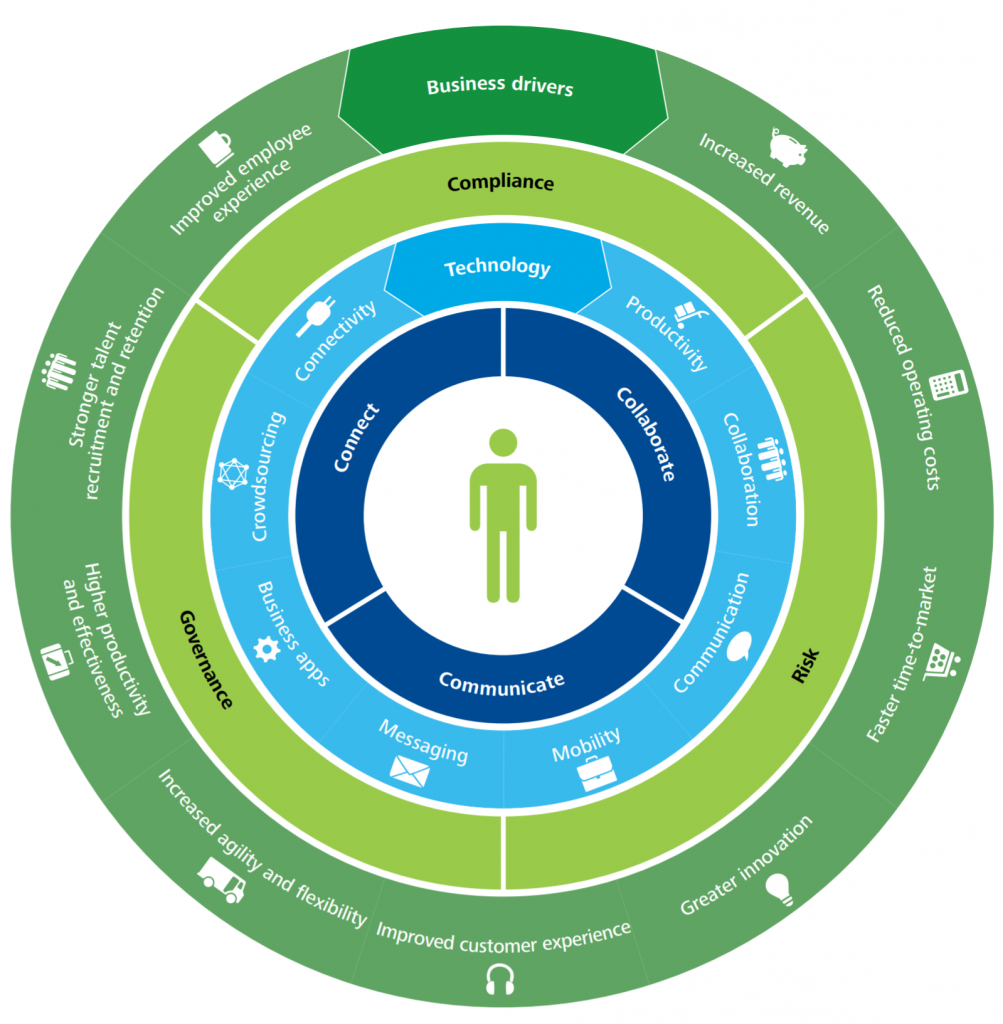Gone are the days when the workplace was merely a physical space, employee occupied during regular office hours. Today’s always connected, instant access environment has blurred the lines between the physical office and the place where work actually happens. As the distinction between professional and personal life dissolves, and the workplace becomes truly digital, employees are communicating and collaborating in unprecedented ways. To enable knowledge sharing across the organization, they want the ability to forge productive business relationships beyond natural work groups. As a result, it is increasingly clear that the traditional ‘create and push’ information approach no longer meets employees’ evolving needs.
To accurately reflect their staff’s changing work experience, leading organizations have begun to implement an entirely new working environment – the digital workplace. By integrating the technologies that employees use (from e-mail, instant messaging and enterprise social media tools to HR applications and virtual meeting tools), the digital workplace breaks down communication barriers, positioning you to transform the employee experience by fostering efficiency, innovation and growth. The key to success, however, lies in the effective implementation of a digital workplace strategy capable of driving true cultural change.
If your business is considering migrating to a digital workplace model, having the right productivity and collaboration tools can make all the difference in making the transition a smooth one. It can certainly increase the chances of being successful in the mid to long-term.
If your business is considering migrating to a digital workplace model, having the right productivity and collaboration tools can make all the difference in making the transition a smooth one. It can certainly increase the chances of being successful in the mid to long-term.
Productivity, collaboration, communication, customer relationship management, and customer support are essential functions for almost every business and making the switch to a digital workplace with as little disruption to these functions as possible is a necessity. Here are some business and a digital workplace expert that have shared their experiences with some of the productivity and collaboration tools that helped transform businesses of all sizes into a digital workplace.
Office 365
Office 365 provides the productivity tools required by a modern enterprise workforce. This guide covers key details, including available applications, system requirements, and subscription options
Microsoft Office 365 is a subscription service that provides users with the basic productivity applications necessary to get work done in the modern enterprise. Productivity applications include, but are not limited to, a word processor, a spreadsheet, an email client, a calendar, and a presentation application. In fact, because of Office 365’s cloud-based structure, the suite of productivity applications is constantly being updated and improved
What is a digital workplace?
The digital workplace can best be considered the natural evolution of the workplace. Comprised of your employees’ technology working environment. The digital workplace encompasses all the technologies people use to get work done in today’s workplace – both the ones in operation and the ones yet to be implemented. It ranges from your HR applications and core business applications to e-mail, instant messaging and enterprise social media tools and virtual meeting tools.
Because most organizations already use many of these components, you generally do not have to build the digital workplace from the ground up. In fact, if your staff respond to e-mails from smartphones, check their pay stubs online or digitally enter a sales opportunity, you may be closer to operating a digital workplace than you think. Yet even in cases where new technologies are required, the benefits increasingly outweigh the costs. As the workplace continues to evolve, and employee expectations shift, organizations that do not embrace the digital workplace risk falling behind.
Why adopt a digital workplace strategy?
If the risks of inaction are not sufficient motivators, the benefits of adopting a digital workplace make a compelling business case. Consider the gains in:
- Talent attraction: 64% of employees would opt for a lower paying job if they could work away from the office.
- Employee productivity: organizations with strong online social networks are 7% more productive than those without.
- Employee satisfaction: organizations that installed social media tools internally found a median 20% increase in employee satisfaction.
- Employee retention: when employee engagement increases, there is a corresponding increase in employee retention by up to 87%.
- Communication tools: information workers prefer newer communication tools, particularly instant messaging, over more traditional ones like e-mail or team workspaces.
The digital workplace framework includes four layers ,
covering the following components:



